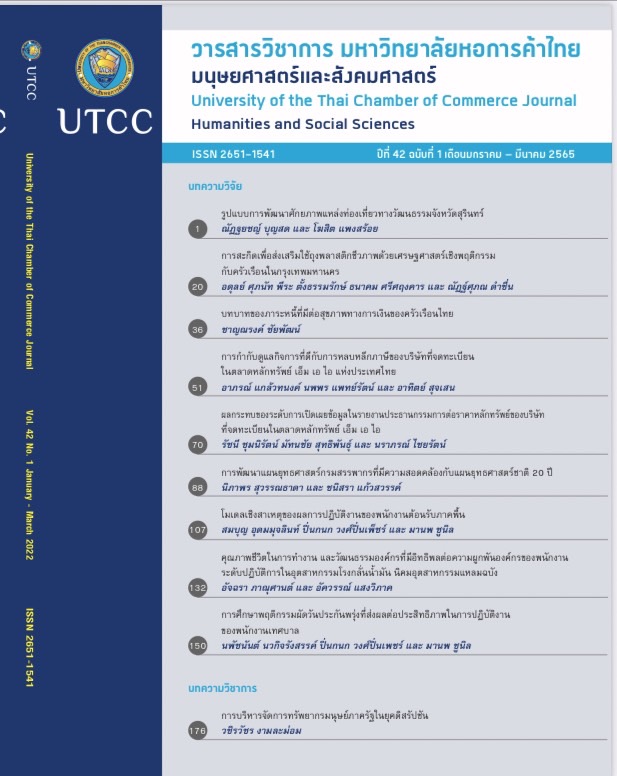Model for Potential Development of Cultural Tourist Attractions in Surin Province
Main Article Content
Abstract
The objectives of this study were 1) to study the problems of cultural tourist sites in Surin Province, 2) to study guidelines for the potential development of cultural tourist attractions in Surin Province, and 3) to propose a model for the potential development of cultural tourist attractions in Surin Province. The research instruments were surveys, observations, interviews, focus-group discussions, and workshops. The sample group consisted of 23 people selected by purposive sampling. The results of the study were presented as follows: 1) the problems of cultural tourist attractions in Surin Province comprised the unclean roads in locals, full of dust and garbage, the lack of foreign language ability among homestay owners, an insufficient number of tour guides, and inefficient management 2) the guidelines for the potential development of cultural tourist attractions in Surin Province consisted of 3 approaches including the general development approach, the development approach regarding the needs of visitors and the development approach of the potential of tourist attractions that was divided into three aspects, namely attraction, carrying capacity and management and 3) the model for the potential development of cultural tourist attractions in Surin Province consists of 7 elements: studying the needs of tourists, proposal development guidelines, best practices for development, follow-up and evaluation, management improvement, and networking and creating partnerships. Finally, the findings of this study can provide guidelines for developing the potential of cultural tourist attractions that is consistent with the needs of tourists and the context of cultural tourism in Surin province.
Article Details

This work is licensed under a Creative Commons Attribution-NonCommercial-NoDerivatives 4.0 International License.
ลิขสิทธิ์ของบทความ
ผลงานที่ได้รับการตีพิมพ์ถือเป็นลิขสิทธิ์ของมหาวิทยาลัยหอการค้าไทย ห้ามมิให้นำเนื้อหา ทัศนะ หรือข้อคิดเห็นใด ๆ ของผลงานไปทำซ้ำ ดัดแปลง หรือเผยแพร่ ไม่ว่าทั้งหมดหรือบางส่วนโดยไม่ได้รับอนุญาตเป็นลายลักษณ์อักษรจากมหาวิทยาลัยหอการค้าไทยก่อน
References
กนกพร ฉิมพลี. (2559). แนวทางการพัฒนาหมู่บ้านท่องเที่ยวเชิงวัฒนธรรมในชุมชนบ้านตะคุ ตำบลตะคุ อำเภอปักธงชัย จังหวัดนครราชสีมา. วารสารชุมชนวิจัย มหาวิทยาลัยราชภัฏนครราชสีมา, 10(1), 7-19.
กรมการท่องเที่ยว. (2557). คู่มือตรวจประเมินมาตรฐานคุณภาพแหล่งท่องเที่ยวทางวัฒนธรรม (พิมพ์ครั้งที่ 2). สืบค้นจาก https://thaits.avalue.co.th/services/uploads/standard/document/files_01042019203726/15541259082340.pdf
กระทรวงการท่องเที่ยวและกีฬา. (2556). รายงานภาวะเศรษฐกิจท่องเที่ยว ฉบับที่ 1 กรกฎาคม - กันยายน2556. กรุงเทพฯ: ผู้แต่ง.
ชุติกาญจน์ กันทะอู. (2560). การท่องเที่ยวโดยชุมชนเป็นฐาน: กรณีศึกษา บ้านร่องฟอง ตำบลร่องฟอง อำเภอเมืองแพร่ จังหวัดแพร่ (วิทยานิพนธ์ปริญญามหาบัณฑิต ไม่ได้ตีพิมพ์). จุฬาลงกรณ์ มหาวิทยาลัย, กรุงเทพฯ
ดุสิตพร ฮกทา. (2560). แผนพัฒนายุทธศาสตร์เพื่อพัฒนาศักยภาพการท่องเที่ยวแบบบูรณาการอย่างยั่งยืน จังหวัดตรัง (วิทยานิพนธ์ปริญญาดุษฎีบัณฑิต ไม่ได้ตีพิมพ์). มหาวิทยาลัยพะเยา.
บุญเลิศ จิตตั้งวัฒนา. (2548). การพัฒนาการท่องเที่ยวแบบยั่งยืน. กรุงเทพฯ: เพรส แอนด์ ดีไซน์.
เบญจมาศ ณ ทองแก้ว, อำนาจ รักษาพล, จุฑามาส เพ็งโคนา, และบุญศิลป์ จิตตะประพันธ์. (2560).ศักยภาพและแนวทางการพัฒนาแหล่งท่องเที่ยวตำบลคันธุลี จังหวัดสุราษฎร์ธานี. วารสารวิจัยเพื่อการพัฒนาเชิงพื้นที่, 9(2), 106-121.
ใบเฟิร์น วงษ์บัวงาม, และมุขสุดา พูลสวัสดิ์. (2556). การประเมินศักยภาพแหล่งท่องเที่ยวเชิงเกษตรโครงการที่ได้รับรางวัลจากการประกวดผลงานตามปรัชญาของเศรษฐกิจพอเพียงในเขตกรุงเทพและปริมณฑล. กรุงเทพฯ: มหาวิทยาลัยเทคโนโลยีราชมงคลพระนคร.
ปารวดี ศิริ. (2563). แนวทางการพัฒนาศักยภาพแหล่งท่องเที่ยวตามเส้นทางเมืองบุญหลวงแห่งล้านนา จังหวัดลำพูน (วิทยานิพนธ์ปริญญาดุษฎีบัณฑิต ไม่ได้ตีพิมพ์). มหาวิทยาลัยพะเยา.
ปุณยวีร์ วิเศษสุนทรสกุล. (2563). แนวทางการพัฒนาศักยภาพการท่องเที่ยวโดยชุมชนจังหวัดนครราชสีมา (วิทยานิพนธ์ปริญญาดุษฎีบัณฑิต ไม่ได้ตีพิมพ์). มหาวิทยาลัยพะเยา.
ภัคจิรา แสนใจ, และสถาพร มงคลศรีสวัสดิ์. (2558). แนวทางการพัฒนาศักยภาพการท่องเที่ยว รูปแบบไมซ (MICE) ในจังหวัดขอนแก่น. วารสารวิชาการ การท่องเที่ยวไทยนานาชาติ, 11(1), 54-67.
สะริญญาลภัสธร์ บูรณะกิติ. (2555). รูปแบบการพัฒนาการท่องเที่ยวเชิงวัฒนธรรมขององค์กรปกครองส่วนท้องถิ่นชุมชนเลียบคลองพระยาบันลือ (วิทยานิพนธ์ปริญญาดุษฎีบัณฑิต ไม่ได้ตีพิมพ์). มหาวิทยาลัยมหาสารคาม.
สำนักงานสถิติจังหวัดสุรินทร์. (2563). รายงานสถิติจังหวัดสุรินทร์ พ.ศ. 2563. สืบค้นจาก http://surin.nso.go.th/images/Report63/Report64/report%202563.pdf
Dodds, R., Ali, A., & Galaski, K. (2018). Mobilizing knowledge: Determining key elements for success and pitfalls in developing community-based tourism. Current Issues in Tourism, 21(13), 1547-1568. https://doi.org/10.1080/13683500.2016.1150257
Mayaka, M., Croy, W. G., & Cox, J. W. (2019). A dimensional approach to community-based tourism: Recognising and differentiating form and context. Annals of Tourism Research, 74, 177-190. https://doi.org/10.1016/j.annals.2018.12.002
Rout, P. C., & Gupta, S. K. (2017). Asset based community development in mountain environs: A strategic application for sustainable community based tourism development in the Jaunsar-Bawar region of Uttarakhand, India. African Journal of Hospitality,
Tourism and Leisure, 6(3), 1-11.
Strydom, A. J., Mangope, D., & Henama, U. S. (2018). Lessons learned from successful community-based tourism case studies from the global south. African Journal of Hospitality,Tourism and Leisure, 7(5), 1-13.


